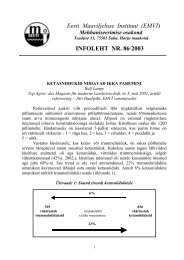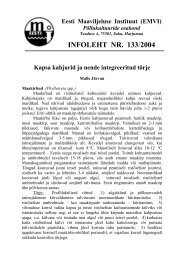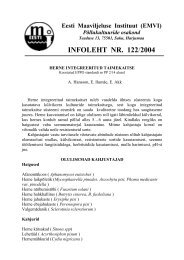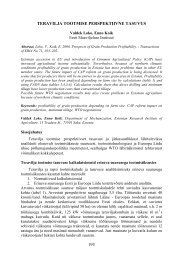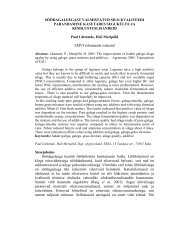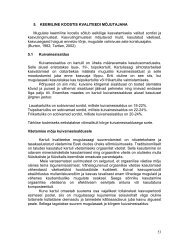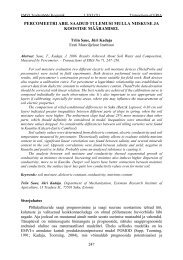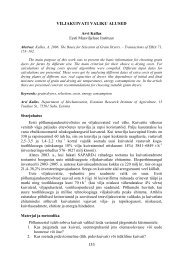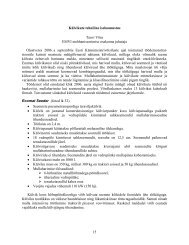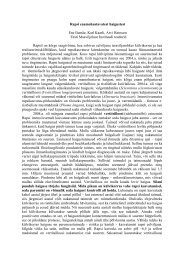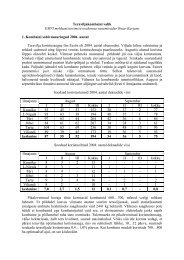Possibilities of growing Camelina sativa in ecological cultivation
Possibilities of growing Camelina sativa in ecological cultivation
Possibilities of growing Camelina sativa in ecological cultivation
You also want an ePaper? Increase the reach of your titles
YUMPU automatically turns print PDFs into web optimized ePapers that Google loves.
<strong>Possibilities</strong> <strong>of</strong> <strong>grow<strong>in</strong>g</strong> <strong>Camel<strong>in</strong>a</strong> <strong>sativa</strong> <strong>in</strong> <strong>ecological</strong> <strong>cultivation</strong>El<strong>in</strong>a Akk, Ene IlumäeEstonian Research Institute <strong>of</strong> AgricultureAbstract. Akk, E., Ilumäe, E. 2005. <strong>Possibilities</strong> <strong>of</strong> <strong>grow<strong>in</strong>g</strong> <strong>Camel<strong>in</strong>a</strong> <strong>sativa</strong> <strong>in</strong> <strong>ecological</strong><strong>cultivation</strong>It is essential to grow cruciferous crops <strong>in</strong> <strong>ecological</strong> crop rotation s<strong>in</strong>ce cruciferous cropsstop the development period <strong>of</strong> cereals pathogens and restra<strong>in</strong> the spread <strong>of</strong> diseases by soil.Compar<strong>in</strong>g the <strong>grow<strong>in</strong>g</strong> <strong>of</strong> oilseed rape, <strong>Camel<strong>in</strong>a</strong> has some preferences. <strong>Camel<strong>in</strong>a</strong> is a goodsupport<strong>in</strong>g crop <strong>of</strong> pea. In case <strong>of</strong> the sow<strong>in</strong>g density <strong>of</strong> pea 60 germ<strong>in</strong>at<strong>in</strong>g seeds per m 2 and<strong>Camel<strong>in</strong>a</strong> the yield <strong>of</strong> mixture was 1768 kg ha -1 .El<strong>in</strong>a Akk, Ene Ilumäe. Department <strong>of</strong> Field crops, Estonian Institute <strong>of</strong> Agriculture, Teaduse13, 75501, Saku, Estonia.The plant is native to southeast Europe and southwest Asia. It occurs mostly as theweed accompany<strong>in</strong>g flax. As a cultivated plant it is known for about 4000 years. In Europe itwas spread as an oil plant <strong>in</strong> the time <strong>of</strong> the ancient Greeks and Romans and <strong>in</strong> the MiddleAges. It was sown purely or <strong>in</strong> mixtures with other crops. The ma<strong>in</strong> growth area was fromEast Europe to Central Asia. Its <strong>grow<strong>in</strong>g</strong> spread dur<strong>in</strong>g and after the wars. In the 20 th centurythe biggest producer was the Soviet Union where <strong>in</strong> 1950 the growth area <strong>of</strong> <strong>Camel<strong>in</strong>a</strong> <strong>sativa</strong>reached up to 300 thousand hectares.<strong>Camel<strong>in</strong>a</strong> <strong>sativa</strong> is an oil plant <strong>of</strong> cruciferous family. <strong>Camel<strong>in</strong>a</strong> is suitable for <strong>grow<strong>in</strong>g</strong> on lessfertilised relatively drier soils with light texture, clay soils are not suitable. The sow<strong>in</strong>g can becarried out rather early, the seeds are capable <strong>of</strong> germ<strong>in</strong>at<strong>in</strong>g at +1…+2 0 C and young plantsresistance to night frosts is good (they stand -2…-10 0 C). After com<strong>in</strong>g up the plant formsquickly a thick rosette, the ma<strong>in</strong> stems start <strong>grow<strong>in</strong>g</strong> <strong>in</strong> about one month after seed<strong>in</strong>g. Theplant is about 50…100 cm high, with a smooth stem which becomes lignified at the time <strong>of</strong>ripen<strong>in</strong>g. It has arrow-shaped leaves <strong>of</strong> 5…8 cm long, the stem branches <strong>in</strong> the upper third <strong>of</strong>the plant. On the top <strong>of</strong> the branches there is clustery <strong>in</strong>florescence with pale yellow flowers.The plant is self-fertilis<strong>in</strong>g, the flower<strong>in</strong>g period lasts for about two weeks. The fruit is about7…10 mm long, a pear-like pod with 8…10 seeds. The seeds are yellow or brownish yellow,very small, the 1000-seeds-weight is about 1 g. The seed is not dribbl<strong>in</strong>g. The plant growsfast, <strong>in</strong> 80…100 days from seed<strong>in</strong>g to harvest<strong>in</strong>g. Its yield level can be compared to spr<strong>in</strong>grape, predom<strong>in</strong>antly 1100…1300 kg ha -1 .<strong>Camel<strong>in</strong>a</strong> is suitable for <strong>grow<strong>in</strong>g</strong> <strong>in</strong> <strong>ecological</strong> production. The impact <strong>of</strong> cruciferous crops isconsidered to be especially important for decreas<strong>in</strong>g the contam<strong>in</strong>ation level <strong>of</strong> cereals rootrot. In addition to that the cruciferous crops br<strong>in</strong>g by the long taproot the nutrients from thelower soil layers to the upper ones which are well assimilated by the crops be<strong>in</strong>g followed.<strong>Camel<strong>in</strong>a</strong> suits compared to other cruciferous crops better for <strong>grow<strong>in</strong>g</strong> <strong>in</strong> <strong>ecological</strong> croprotation s<strong>in</strong>ce the occurrence <strong>of</strong> pests typical <strong>of</strong> rape is unimportant (no appearance <strong>of</strong>Phyllotreta spp., Meligethes spp. appears to a very small extent). Therefore <strong>in</strong> <strong>ecological</strong>production compar<strong>in</strong>g the <strong>grow<strong>in</strong>g</strong> <strong>of</strong> rape and <strong>Camel<strong>in</strong>a</strong> the essentially higher yields havebeen received by <strong>grow<strong>in</strong>g</strong> <strong>Camel<strong>in</strong>a</strong> (Makowski, 2003). The same rape diseases endanger<strong>Camel<strong>in</strong>a</strong>. The bigger danger can be caused by – Sclerot<strong>in</strong>ia sclerotiorum, Verticilliumlongisporum and Plasmodiophora brassicae. In <strong>ecological</strong> crop rotation it is possible to avoidthese diseases especially by long crop rotation. <strong>Camel<strong>in</strong>a</strong> gets contam<strong>in</strong>ated withPeronospora parasitica /camel<strong>in</strong>ae/, Botrytis c<strong>in</strong>erea and Alternaria brassicae to some1
extent. Contam<strong>in</strong>ation by Phoma l<strong>in</strong>gam, Cyl<strong>in</strong>drosporium concentricum andMycosphaerella brassicicola is unimportant. Engag<strong>in</strong>g <strong>Camel<strong>in</strong>a</strong> <strong>in</strong> crop rotation and <strong>in</strong> case<strong>of</strong> frequent <strong>grow<strong>in</strong>g</strong> the danger <strong>of</strong> diseases and pests <strong>in</strong>creases.<strong>Camel<strong>in</strong>a</strong> oil is be<strong>in</strong>g used mostly for <strong>in</strong>dustrial purpose: by good energetic characteristics itis well suitable for mak<strong>in</strong>g biodiesel fuel. For mak<strong>in</strong>g pa<strong>in</strong>ts and l<strong>in</strong>oleum it is be<strong>in</strong>g usedtogether with other plant oils. It is also used for mak<strong>in</strong>g green soap. Some parts <strong>of</strong> oil and oilfreemeal composition (eicosenoic and erucic acid, glucos<strong>in</strong>olates) restrict its use for humanfood and animal feed. In late years its development work has achieved good results <strong>in</strong>elim<strong>in</strong>at<strong>in</strong>g eicosenoic acid content. The use <strong>of</strong> <strong>Camel<strong>in</strong>a</strong> oil is limited by high content <strong>of</strong>unsaturated fatt<strong>in</strong>g acids although the oil conta<strong>in</strong>s several natural protection means aga<strong>in</strong>stoxidis<strong>in</strong>g – antioxidants- e.g. toc<strong>of</strong>erol. The fatty acid consistence <strong>of</strong> <strong>Camel<strong>in</strong>a</strong> oil is shown<strong>in</strong> table 1 (Makowski, 2003). The high consistence <strong>of</strong> l<strong>in</strong>olenic and eicosenoic acid makes thetaste unsatisfactory.Table 1 Fatty acid composition <strong>of</strong> <strong>Camel<strong>in</strong>a</strong> and spr<strong>in</strong>g rape<strong>Camel<strong>in</strong>a</strong>Average In Trials Spr<strong>in</strong>g rape(ERIA)Oil content 35…40 36…37 40…45Palmitic (C16:0) 5…8 6.07 3…6Stearic (C18:0) 2…3 2.54 1…3Oleic (C18:1) 13…21 13.2 55…65L<strong>in</strong>oleic (18:2) 15…20 20.8 20…25L<strong>in</strong>olenic (18:3) 30…40 35.5 6…14Eicosenoic (20:1) 13…20 12,35 0…2Erucic (22:1) 3…4 3.6 0…2<strong>Camel<strong>in</strong>a</strong> <strong>grow<strong>in</strong>g</strong> is generally carried out accord<strong>in</strong>g to the same pr<strong>in</strong>ciples as <strong>grow<strong>in</strong>g</strong> rape.Perfect soil tillage together with plough<strong>in</strong>g has to guarantee weed control. Pre-sow<strong>in</strong>g soiltillage favours germ<strong>in</strong>ation <strong>of</strong> weed seeds and the shoots are damaged <strong>in</strong> the last pre-sow<strong>in</strong>gtillage. S<strong>in</strong>ce the seed is small, it is especially essential to form the good seed basisguarantee<strong>in</strong>g low sow<strong>in</strong>g and soil moisture. Pre-sow<strong>in</strong>g roll<strong>in</strong>g tightens the soil loosened bycultivat<strong>in</strong>g-harrow<strong>in</strong>g. The soil be<strong>in</strong>g rolled must not be wet. For early sow<strong>in</strong>g the soil tillagehas to be started possibly early. Clover should be used <strong>in</strong> <strong>ecological</strong> crop rotation whichenriches the soil with biologically fixed air-nitrogen guarantee<strong>in</strong>g <strong>Camel<strong>in</strong>a</strong> the neededamount <strong>of</strong> N <strong>in</strong> soil. Clover is an essential crop <strong>in</strong> the control <strong>of</strong> perennial weeds. Therecommended sow<strong>in</strong>g time is together with cereals sow<strong>in</strong>g or immediately after that.<strong>Camel<strong>in</strong>a</strong> comes up fast, earlier than essential weeds. Relatively high density <strong>of</strong> plant per m 2and narrow-rowed sow<strong>in</strong>g are important primarily for fight<strong>in</strong>g with annual weeds. Due torapid primary development <strong>Camel<strong>in</strong>a</strong> suppresses annual weeds. Individually grown <strong>Camel<strong>in</strong>a</strong>plants are not competitive with weeds; <strong>Camel<strong>in</strong>a</strong> cannot compete with perennial weeds,either. In <strong>ecological</strong> production trial the harrow<strong>in</strong>g <strong>of</strong> pea and <strong>Camel<strong>in</strong>a</strong> mixture damaged<strong>Camel<strong>in</strong>a</strong> plants and the mixed sow<strong>in</strong>g rema<strong>in</strong>ed sparse.In the trial carried out <strong>in</strong> the Estonian Research Institute <strong>of</strong> Agriculture the rates <strong>of</strong> 4.0 kgha -1 (400 germ<strong>in</strong>at<strong>in</strong>g seeds per m 2 ) <strong>in</strong> a pure stand and <strong>in</strong> the mixtures with the pea ’Majoret’3.0 kg ha -1 (300 germ.seeds per m 2 ) were applied. The average humus content <strong>of</strong> soil was 3,0%, P 102 mg kg -1 and K 182 mg kg -1 . The field trials were situated on soddy-calcareous soil,preced<strong>in</strong>g crop was spr<strong>in</strong>g barley. It was sown with a narrow row space. Grow<strong>in</strong>g the mixture<strong>of</strong> pea and <strong>Camel<strong>in</strong>a</strong> the pea fixes the air-nitrogen <strong>in</strong> the soil additionally (60 kg ha -1 ), whichcovers the growth-time need <strong>of</strong> nitrogen for <strong>Camel<strong>in</strong>a</strong>. <strong>Camel<strong>in</strong>a</strong> is a good support<strong>in</strong>g crop2
for pea. It is essential to f<strong>in</strong>d the suitable sow<strong>in</strong>g density <strong>of</strong> pea <strong>in</strong> the mixed sow<strong>in</strong>g <strong>of</strong> peaand <strong>Camel<strong>in</strong>a</strong>. In the <strong>grow<strong>in</strong>g</strong> density <strong>of</strong> pea 80 germ<strong>in</strong>at<strong>in</strong>g seeds per m 2 and <strong>of</strong> gold-<strong>of</strong>pleasure300 germ<strong>in</strong>at<strong>in</strong>g seeds per m 2 , there was a competition between plants which alsoreflected <strong>in</strong> the yield (figure 1). The total yield <strong>of</strong> pea and <strong>Camel<strong>in</strong>a</strong> ’Ligena’ was 1307 kg ha -1 . In case <strong>of</strong> the sow<strong>in</strong>g density <strong>of</strong> pea 60 germ<strong>in</strong>at<strong>in</strong>g seeds per m 2 and <strong>of</strong> <strong>Camel<strong>in</strong>a</strong> 300germ<strong>in</strong>at<strong>in</strong>g seeds per m 2 the yield was 1768 kg ha -1 (LSD 95%... 161.7). Compar<strong>in</strong>g the prote<strong>in</strong>yields the mixture <strong>of</strong> pea (60 g.s.) and <strong>Camel<strong>in</strong>a</strong> overcame the prote<strong>in</strong> yield <strong>of</strong> pea pure standby 83.5 kg ha -1 . In the mixed sow<strong>in</strong>gs <strong>of</strong> pea the prote<strong>in</strong> content <strong>of</strong> pea was somewhat lowerthan <strong>in</strong> the pure stand (<strong>in</strong> mixtures 21.5%, <strong>in</strong> a pure stand 22.5%). The prote<strong>in</strong> content <strong>of</strong><strong>Camel<strong>in</strong>a</strong> <strong>in</strong> the trial was 24.4% and the oil content 37.1…38.3 %.Yield, kg ha-1; Prote<strong>in</strong> yield kg ha-120001800160014001200100080060040020001 2 3 41. Pea 60 g.s. + <strong>Camel<strong>in</strong>a</strong>; 2. Pea 80 g.s. + <strong>Camel<strong>in</strong>a</strong>; 3. Pea100 g.s.; 4. <strong>Camel<strong>in</strong>a</strong>Figure 1. The seed and prote<strong>in</strong> yield <strong>of</strong> <strong>Camel<strong>in</strong>a</strong> and pea mixtures and pure standsSummary1. <strong>Camel<strong>in</strong>a</strong> <strong>sativa</strong> is a cruciferous crop which suits for <strong>ecological</strong> <strong>cultivation</strong> s<strong>in</strong>ce thedanger <strong>of</strong> diseases and pests is relatively small.2. Agrotechnology <strong>of</strong> <strong>Camel<strong>in</strong>a</strong> (soil tillage) is similar to agrotechnology applied <strong>in</strong> rape<strong>cultivation</strong>.3. The method <strong>of</strong> eradicat<strong>in</strong>g weeds <strong>in</strong> <strong>ecological</strong> <strong>cultivation</strong> – harrow<strong>in</strong>g – is not suitable <strong>in</strong>early stadium <strong>of</strong> <strong>grow<strong>in</strong>g</strong> <strong>Camel<strong>in</strong>a</strong>.4. By sufficient growth density <strong>Camel<strong>in</strong>a</strong> plants can suppress weeds.5. Grow<strong>in</strong>g <strong>in</strong> the mixture with pea, <strong>Camel<strong>in</strong>a</strong> is a good support<strong>in</strong>g crop for pea. Pea fixesair-nitrogen by which it guarantees the need for nitrogen at the time <strong>of</strong> <strong>Camel<strong>in</strong>a</strong> <strong>grow<strong>in</strong>g</strong>.References:1. Makowski, N. 1993. Anbau von Le<strong>in</strong>dotter, Raps 2, S. 73-77.2. Makowski, N. Anbautelegramm Sommerle<strong>in</strong>dotter, 7 S. (Planmässige Vorschrift)3. Makowski, N. Mischanbau mit Le<strong>in</strong>dotter, 10 S. (Planmässige Vorschrift)3



